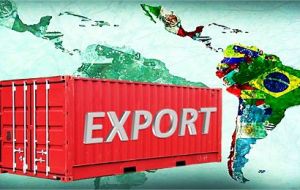MercoPress. South Atlantic News Agency
Latin America's exports expected to increase 10%, following four years of declining prices
 Latin America and the Caribbean participation in total global service exports in 2016 was just 3.1%, compared with 5.6% of global goods exports.
Latin America and the Caribbean participation in total global service exports in 2016 was just 3.1%, compared with 5.6% of global goods exports.  The weight of the farm sector in regional exports has increased sharply in this century, rising from 17% in 2000 to 26% in 2016.
The weight of the farm sector in regional exports has increased sharply in this century, rising from 17% in 2000 to 26% in 2016.  However the region’s participation in global agricultural exports has also grown, although to a lesser extent: from 10% in 2000 to 13% in 2016.
However the region’s participation in global agricultural exports has also grown, although to a lesser extent: from 10% in 2000 to 13% in 2016. In 2017 Latin America and the Caribbean will have left behind half a decade of prices decline of its export basket plus a weak increase in the exported volume, achieving an overall 10% growth in the value of its shipments abroad, according to new estimates released by ECLAC in Chile.
The Economic Commission for Latin America and the Caribbean (ECLAC) unveiled its annual International Trade Outlook for Latin America and the Caribbean 2017 report which it indicates that the region’s imports will also recover, some 7%, after four years of declining values.
Although there is great uncertainty in the international arena, various factors have contributed to the trade recovery in Latin America and the Caribbean: greater dynamism in aggregate demand in some of its main trading partners; a return to economic growth in the region itself, which is expected to grow 1.2% in 2017 and 2.2% in 2018, after two years of recession; higher prices for several of its basic export products; and the dismantling of tariff and non-tariff barriers in some countries.
According to the document, the recovery in exports this year will be led by shipments to China and the rest of Asia (23% and 17% value increase, respectively) while exports to the United States and within the region will expand at a rate near average (9% and 10%, respectively). Meanwhile, sales to the European Union will be less dynamic (with a 6% increase).
With regard to trade within the region, a rebound is expected in all its sub-regions, especially in South America. For the year as a whole, growth in the value of intraregional exports is forecast at 10%. Their percentage incidence of the region’s total shipments abroad is estimated at 16.8%, below the maximum level of 22% reached in 1994.
The report points out that intraregional trade offers great potential for the export of manufactured goods and more elaborated products. “This highlights the urgent need to deepen regional integration, even more so considering the recent shift in U.S. trade policy and the uncertainty associated with the renegotiation of the North American Free Trade Agreement (NAFTA)”.
In reference to the region's performance in modern services, those with high value-added and are intensive in the use of Information and Communications Technology (ICT). This category includes telecommunications and IT services, financial services, insurance and pension services, royalties for the use of intellectual property, and diverse business services. Several of these activities offer the region’s countries interesting opportunities to attract foreign investment, linked to outsourcing processes, for example.
According to the document, in this area Latin America and the Caribbean continues to be a marginal actor. Its participation in total global service exports in 2016 was just 3.1%, compared with 5.6% of global goods exports. More specifically, its share of the export of modern services was just 1.8%.
The document also addresses the challenges of Latin America and the Caribbean in the global agriculture trade as a net exporter. The weight of the farm sector in regional exports has increased sharply in this century, rising from 17% in 2000 to 26% in 2016. Meanwhile, the region’s participation in global agricultural exports has also grown, although to a lesser extent: from 10% in 2000 to 13% in 2016.
ECLAC emphasizes that agricultural exports showed greater resilience in the 2012-2016 period, which marked the region’s worst export performance since the 1930s. While the value of regional agricultural exports fell just 1% during that period, the contraction in total exports was 21%, as a result of four consecutive years of declines.
In the last decade, South America has accounted on average for 80% of the value of the region’s agricultural exports, Mexico 11%, Central America 7% and the Caribbean just 1%. The regional export basket is dominated by basic products such as raw cane sugar, coffee (not roasted or decaffeinated), soybeans, soy meal, maize and frozen beef. In contrast, the region shows a poor export performance in processed products.
According to ECLAC, the current high concentration in raw materials imposes the urgent challenge of “de-commoditizing” the export basket, which is also true of other sectors related to natural resources. Officials must generate conditions that are more favorable to processing those products that today the region exports almost exclusively in their raw form. To achieve more active industrial policies – implemented in the context of public-private alliances – are essential.




Top Comments
Disclaimer & comment rules-

Read all commentsExcellent! What's the % of the rise in the “exports” of drugs?
Nov 12th, 2017 - 04:42 pm 0Commenting for this story is now closed.
If you have a Facebook account, become a fan and comment on our Facebook Page!